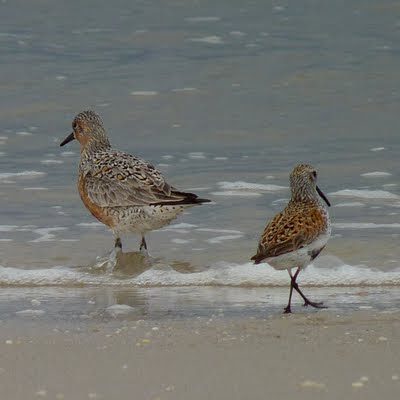When I started birding several years ago, I eagerly sought whatever resources I could find to help myself learn to identify birds. Of course, I bought a few field guides, with The Sibley Guide to Birds being the one I relied on the most. I also looked for books that went beyond what a traditional field guide offers. One book that proved especially useful was Kenn Kaufman's Advanced Birding, published in 1990 in the Peterson Field Guide series. Kaufman's Advanced Birding taught general principles of bird identification and gave the reader tips on how to separate particularly difficult species groups. Kaufman discussed how to sort out winter loons, scaup, dowitchers, terns, Empidonax flycatchers, chickadees, and fall warblers, among many others. I still refer to the original guide from time to time to refresh my memory on some points.
Even a quick scan through the table of contents reveals that the new version is significantly different. Most of the chapters in the first edition treated problematic pairs or small groups of species, such as medium-sized terns or dowitchers. In the new edition, some of these groups or pairs are treated, but more have been dropped or reduced in favor of discussing whole families. Of the 31 chapters in the new edition, 14 start with the phrase "Learning to Identify" followed by the name of a family or order, such as diurnal raptors or warblers. Four chapters on gulls in the older edition have been condensed into a single chapter on the basics of learning gulls. Four chapters on shorebirds are reduced to two, one on shorebird basics and the other on the small Calidris sandpipers (a.k.a. "peeps").
This may sound a loss of content, but most of the same ground is still covered, in one form or another. The "Learning to Identify" chapters present the traits of subgroups within a family or order – usually genus by genus – and then discuss characteristics that are useful for identifying those birds. The most useful characteristics vary from family to family. For example, for waterfowl, Kaufman suggests looking at traits like feeding and flocking behaviors, head and bill structure, upperwing patterns, and flight styles. For warblers, look at things like overall shape, foraging behaviors, wing patterns, and facial patterns. Microhabitat – i.e., where on a lake or marsh a duck forages or where on a tree a warbler gleans insects – can be useful for both groups. Kaufman also discusses potential identification problems, such as molt changing the expected plumage patterns, hybridization, and the introduction of exotic birds (especially among waterfowl).
A further change to the new edition is the addition of several introductory chapters on building identification skills. These cover topics like approaches to bird identification, potential pitfalls that affect all bird groups, bird topography, plumage and molt, using vocalizations and behavior for identification, and techniques for improving skills. Together these make up almost a third of the new Advanced Birding. I read the chapters on bird topography and molt on my way to Cape May a couple weeks ago for bird banding, and they gave me some new insights into what I was seeing on the birds in my hands. I think Kaufman's chapter on molt is particularly worth reading, as he has a talent for making complex concepts easily understandable. It is a simpler and more concise explanation of the terms and concepts for molt than you might find in a book like Molt in North American Birds.
The revised Kaufman Field Guide to Advanced Birding: Understanding What You See and Hear has much to recommend it. The new edition seeks to address a context in which more and more information is available on the finer points of bird identification but not as much on how to fit all those details together. Advanced Birding teaches fundamental skills for recognizing birds in the field that are important for all birders to understand. However, it will be particularly useful to beginner and intermediate-level birders who have some field experience but need help understanding what they see in the field. Birders who wish to improve their identification skills would do well to acquire and read this book. If you can find a copy of the first edition, it is still worth reading, as it contains a lot of fine-grain information and sketches of feather patterns that are not in the new edition.
* Advanced Birding is now the sixth guide in the Kaufman Field Guide series. After my experiences using the butterfly and insect guides, which I consult almost daily in the warmer months, I hope that the series will grow to include separate guides for more insect groups, such as dragonflies and damselflies, moths, beetles, true bugs, and bees and wasps.
This review was based on a review copy provided by Houghton Mifflin Harcourt.























































